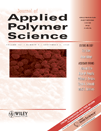Study on the rheological behavior of the hydrophobically modified hydroxyethyl cellulose with 1,2-epoxyhexadecane*
Abstract
Through the macromolecule reaction method, the hydrophobically modified hydroxyethyl cellulose (EP16–HAHEC) was synthesized using 1, 2-epoxyhexadecane as the hydrophobic monomer. The solution properties of EP16–HAHEC were comprehensively investigated, which showed that the polymer with enhanced; viscosification property, thermal stability, shear resistance, and salt resistance was obtained. Amphiphilic structure of EP16–HAHEC molecules contributed to the surface activity of the polymer. By forming complex solution with surfactants or carboxylmethyl cellulose (CMC), the viscosification property of EP16–HAHEC could be enhanced through the interactions of hydrophobic groups and hydrogen bonds. The viscosity-enhancing mechanism of HAHEC was studied by the environment scan electronic microscope (ESEM) and the fluorescence spectrum measurements, which demonstrated that the formation of the supramolecular aggregation networks was coincident with the increase of the apparent viscosity of HAHEC. With the gradual formation of the complete polymer molecule networks, the apparent viscosity rised dramatically, and the associating aggregations of the polymer molecules appeared far before the great change of the macroproperty of the polymer. © 2006 Wiley Periodicals, Inc. J Appl Polym Sci 101: 2953–2959, 2006




